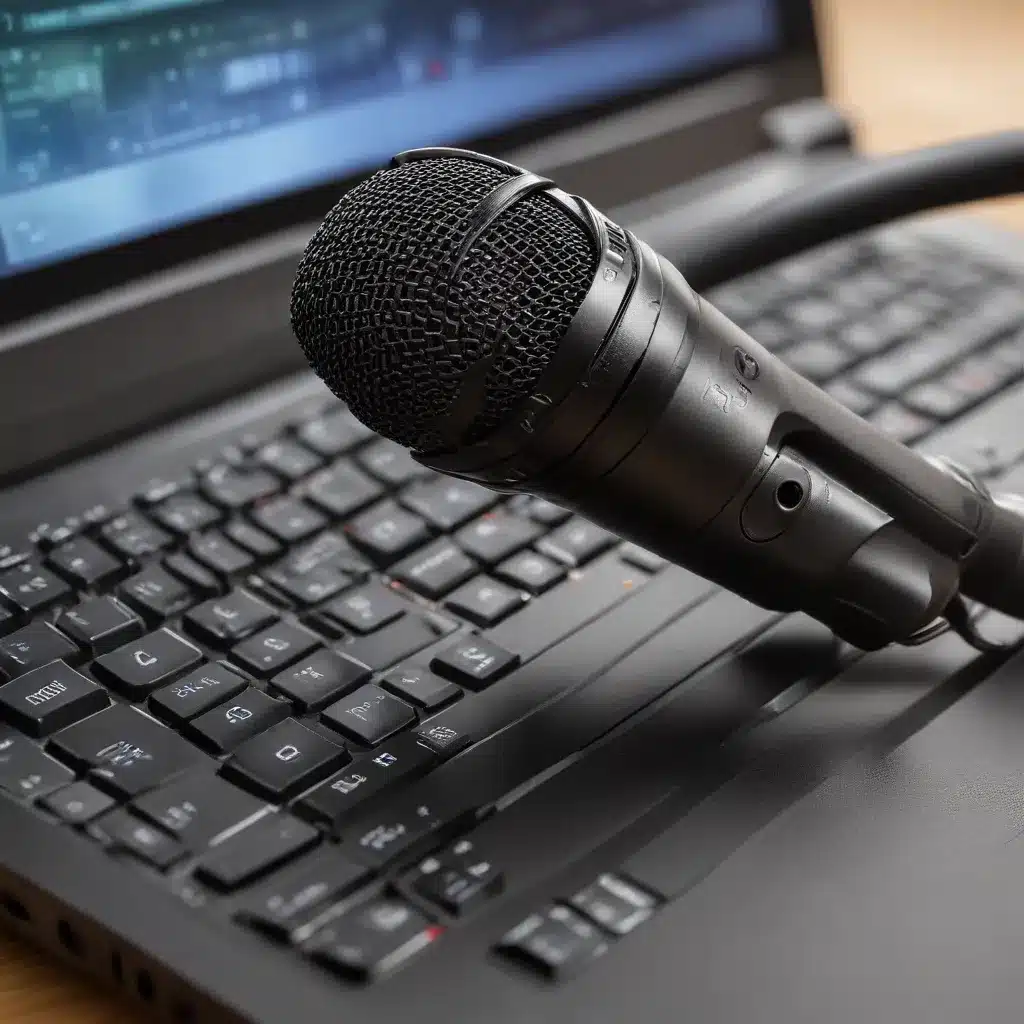
Understanding the Limitations of Laptop Microphones
As an experienced IT professional, I’ve encountered countless users frustrated by the subpar audio quality of their laptop microphones. While laptop manufacturers have made significant strides in improving built-in microphone capabilities, the reality is that these integrated solutions often fall short when it comes to professional-grade audio recordings.
The primary limitations of laptop microphones stem from their compact design and placement within the device. Cramped internal spaces, proximity to noise-generating components like fans and hard drives, and the inherent compromises of miniaturization all contribute to less-than-ideal sound capture. Additionally, laptop microphones are typically omnidirectional, meaning they pick up ambient noise and room acoustics, resulting in recordings that lack clarity and presence.
Exploring External USB Microphone Options
For users seeking to elevate the quality of their audio recordings, upgrading to an external USB microphone is often the most practical solution. These standalone microphones offer several advantages over their laptop-integrated counterparts:
-
Improved Directional Pickup: External USB microphones, such as the popular Audio-Technica AT2020 or Blue Yeti, feature cardioid or supercardioid polar patterns, which focus on capturing sound from the front while rejecting noise from the sides and rear. This results in cleaner, more professional-sounding recordings.
-
Optimized Placement: By positioning the microphone closer to the sound source and away from laptop noise sources, you can significantly improve the signal-to-noise ratio, leading to a richer, more natural-sounding audio capture.
-
Higher-Quality Components: External USB microphones often utilize higher-quality diaphragms, electronics, and signal processing compared to integrated laptop mics, delivering a more detailed and accurate representation of your voice.
-
Increased Flexibility: Many external USB microphones come with adjustable gain controls, allowing you to fine-tune the input level and prevent clipping or distortion. This level of control is crucial for achieving the perfect balance in your recordings.
Addressing the Drawbacks of USB Microphones
While USB microphones offer numerous benefits, it’s essential to be aware of their potential drawbacks as well:
-
Latency Concerns: Depending on the specific microphone and the computer’s processing power, some users may experience noticeable latency or audio-visual synchronization issues when using a USB microphone. This can be problematic for real-time applications like video conferencing or live streaming.
-
Compatibility Challenges: USB microphones may not always play nicely with older or less powerful laptops, as they require sufficient processing power and available USB ports. Ensuring compatibility with your specific hardware and software setup is crucial before making a purchase.
-
Limited Connectivity Options: USB microphones are inherently limited to a single connection to your laptop or computer. This can be a concern if you need to record multiple audio sources simultaneously or integrate the microphone into a more complex audio setup.
Exploring Alternative Audio Interface Solutions
To address the limitations of both laptop-integrated and USB microphones, some users may opt for an external audio interface solution. These devices, such as the Focusrite Scarlett 2i2 or the PreSonus AudioBox USB 96, offer a range of benefits:
-
Superior Audio Quality: Audio interfaces typically feature higher-quality analog-to-digital converters (ADCs) and preamps, resulting in a cleaner, more detailed audio capture compared to integrated or USB microphone solutions.
-
Increased Connectivity: Many audio interfaces provide multiple input and output options, allowing you to connect not only a microphone but also other audio sources, such as instruments or line-level devices. This flexibility enables more advanced recording and production setups.
-
Improved Monitoring: Audio interfaces often include dedicated headphone outputs and volume controls, providing you with better control over your monitoring setup and reducing latency issues.
-
Expandability: As your recording needs evolve, an audio interface can serve as the foundation for a more comprehensive audio ecosystem, allowing you to add additional microphones, MIDI controllers, or other peripherals.
Optimizing Your Recording Environment
Regardless of the microphone or audio interface you choose, the quality of your recordings can be significantly impacted by your physical recording environment. Here are some tips to consider:
-
Minimize Background Noise: Identify and address any sources of ambient noise, such as fans, air conditioning units, or external sounds, that can interfere with your recordings. Consider using soundproofing materials or relocating your setup to a quieter location.
-
Enhance Room Acoustics: The acoustic properties of your recording space can have a profound effect on the final audio quality. Experiment with sound-absorbing materials, like acoustic panels or foam, to reduce echo and reverberation, creating a more controlled and professional-sounding environment.
-
Utilize Accessories: Investing in accessories like pop filters, windscreens, or isolation shields can help mitigate common audio issues, such as plosives (strong bursts of air) or unwanted room reflections.
Putting It All Together: A Balanced Approach
When it comes to upgrading your laptop’s microphone capabilities, a balanced approach is often the most effective. Consider the following steps to achieve the best results:
-
Assess Your Needs: Determine the primary use cases for your audio recordings, whether it’s for podcasting, video voiceovers, or general voice communications. This will help you prioritize the features and performance characteristics that are most important to you.
-
Research and Compare Options: Explore the various external USB microphone and audio interface solutions available, reading reviews, and comparing specifications to find the right fit for your budget and requirements.
-
Optimize Your Recording Environment: Invest time and effort into creating a suitable recording space, incorporating acoustic treatments and accessories as needed to minimize environmental interference.
-
Test and Refine: Conduct thorough testing of your setup, making adjustments to microphone positioning, gain levels, and other settings until you achieve the desired audio quality.
By following this balanced approach, you can elevate the performance of your laptop’s microphone, delivering professional-grade audio recordings that will impress your audience and enhance your content creation endeavors.
Remember, the IT Fix blog is here to provide you with practical tips and in-depth insights on technology, computer repair, and IT solutions. Keep exploring our resources to stay ahead of the curve and unlock the full potential of your computing experience.












